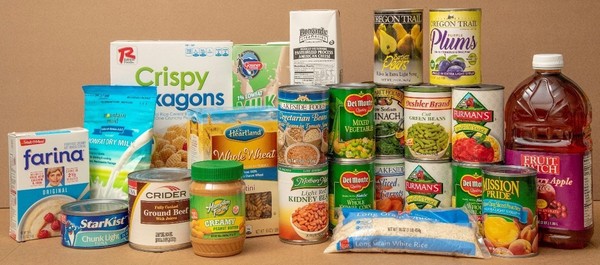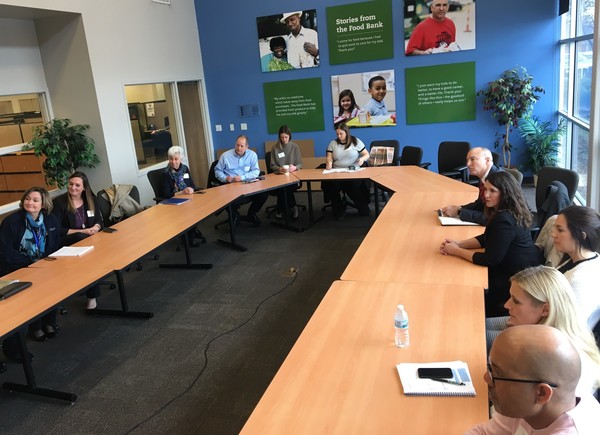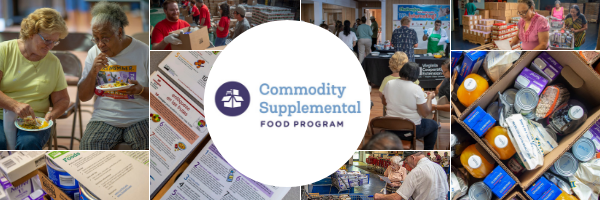News & Notes
The Enhanced CSFP Food Package is Here!
This month, the rollout of the exciting Enhanced CSFP Food Package changes began! Some key differences you may see include:
- Double the amount of vegetables,
- More units of protein,
- Flexibility to provide an additional unit of fruit in place of one unit of juice,
- New food options in almost every food category, and
- Smaller package sizes that allow clients to receive a greater variety of food options each month.
For a more detailed overview of changes and resources for implementation, click here. We hope that clients will find the enhanced food package more appealing and helpful in meeting food needs.
We look forward to hearing feedback about how the enhanced CSFP Food Package is being received by clients. Please send photos, quotes, or stories to USDAFoods@usda.gov.

Featured Food
Dry Beans
Dry beans, lentils, and peas are an excellent addition to any meal and provide endless culinary options. They are a great source of protein, iron, and fiber, and are naturally free from sodium, fat, and cholesterol. Dry beans, lentils, and peas come in many varieties such as black beans, kidney beans, pinto beans, navy beans as well as yellow and red lentils, and green peas. Cooking dry beans, lentils, and peas can be easy but it is important to plan ahead and follow these simple steps.
|
Cooking with Dry Beans
- Clean. Remove any foreign objects like small stones or broken beans.
- Rinse. Place the beans in a colander and rinse them using cold water.
- Soak. There are two different soaking methods:
- Hot Soak (Recommended)
-
- Place beans in a large pot and add 10 cups of water for every 2 cups of dry beans.
- Heat to boiling and boil for an additional 2-3 minutes.
- Remove beans from heat, cover, and let stand for 4-24 hours.
- Drain beans and discard soak water.
- Rinse beans with fresh, cool water.
- Quick Soak (Fastest Method)
-
- Place beans in a large pot and add 6 cups of water for every 2 cups of beans.
- Heat to boiling and boil for an additional 2-3 minutes.
- Remove beans from heat, cover, and let stand for 1 hour.
- Drain beans and discard soak water.
- Rinse beans with fresh, cool water.
4. Cook. Place soaked, rinsed beans in a large pot and cover with fresh cold water. Simmer over medium heat to prevent the beans from splitting. Beans expand while cooking, add more water to the pot as necessary. Depending on the variety, beans can take 30 minutes to 2 hours to cook. Beans are fully cooked when they are tender, but not mushy.
Cooking with Dry Lentils and Peas
- Clean. Remove any foreign objects like small stones or broken pieces.
- Rinse. Place in a colander and rinse using cold water.
- Cook. Lentils and peas are smaller in size and do not require soaking prior to cooking. Place soaked, rinsed, lentils or peas in a medium pot and cover with fresh cold water. Simmer over medium heat until tender. Depending on the variety, lentils and peas can take 20 to 45 minutes to cook.
Inspired to try dry beans, lentils, or peas at your next meal? Check out these delicious recipes:
Lemon Lentil Soup with Dill
Sweet Pea Pancakes
Black Bean Tostadas
Do you have a favorite dry bean, lentil, or pea recipe you’d like to share? If so, send your recipe to USDAFoods@usda.gov. Please review our Recipe Criteria for submitting recipes.
Program Spotlight
Food Purchase Distribution Program in Action in Cleveland, Ohio
In December 2019, a group of USDA Agency Administrators, including Food and Nutrition Service Administrator Pam Miller, joined MWRO staff on a visit to the Greater Cleveland Food Bank (GCFB) in Ohio to see the Food Purchase Distribution Program (FPDP) in action. The goal of the visit was to learn more about the effects of the FPDP in the community.
As the group toured the food bank, they saw USDA Foods in use, volunteers packing meals, and an enormous refrigerated storage area. Afterwards, food bank staff shared information on their work and programs, specifically highlighting ways they utilize USDA Foods.
Customer feedback was provided on the 60 thousand gallons of fresh milk received through FPDP this year. Partner organization Grace Episcopal stated, “The fresh milk has been a blessing to the community.”
The GCFB is the largest hunger relief organization in Northeast Ohio having served over 350,000 people in 2019 through more than 1,000 partner organizations across six counties. Partner organizations include local food pantries, hot meal programs, shelters, mobile pantries, and other non-profit agencies. GCFB prepares nutritious meals in their Food Bank Kitchen and processes hundreds of calls a day in their help center where they refer callers in-need to local agencies and sign-up eligible Northeast Ohioans for SNAP and other nutrition benefits.

USDA staff learn about the FPDP and the great work being done at the Greater Cleveland Food Bank in Ohio.
Policy Corner
CSFP 2020 Caseload
On January 8, USDA issued the Commodity Supplemental Food Program (CSFP) caseload and administrative grants for 2020. CSFP is funded at $245 million for FY 2020. Based on this funding, FNS issued final caseload assignments, or the number of people each State or Indian Tribal Organization (ITO) is authorized to serve. The 2020 national caseload level is equal to last year's caseload level of 736,110. FNS assigns caseload in accordance with program regulations at 7 CFR 247.21 and annual appropriations legislation.
For more information on caseload management best practices you can attend USDA's February 20, 2020 webinar CSFP Caseload Management at 1:30pm EST. Click here to register for the webinar.
Complaint Resolution Pipeline
USDA Foods Winter Storage Guidance
As winter weather blows frigid temperatures across the country it is important for all State Distributing Agencies (SDAs), Recipient Agencies (RAs), and Indian Tribal Organizations (ITOs) to properly transport and store USDA Foods during the winter months. Canned products may freeze if exposed to freezing temperatures for a long period during shipment in a dry container. Fresh produce may freeze if there are multiple delivery locations and produce is stored near rear doors exposed to freezing temperatures while doors are open to unload product.
Warehousing and distribution staff should be trained on how to properly receive and store USDA Foods. Examining the product as it is being received helps reduce problems later. It is important that sufficient time is taken to inspect the product, open cases, and, if needed, open internal packaging to check the product. Take action immediately if the product does not meet specifications. Document and report any issues and include supporting photos. SDAs should report all complaints through the Web-Based Supply Chain Management System (WBSCM).
Ideally, dry storage areas should be maintained at a temperature of 70º F or below unless product specific storage directions are provided. USDA Foods placed in a freezer (0º F or below) or a refrigeration unit (40º F or below) should remain in these storage conditions until use. Keeping a consistent temperature will help to prevent the build up of condensation in packaging which can lead to mold, rusty cans, and the deterioration of bagged/boxed goods.
Receipt and storage condition temperatures of USDA Foods should be recorded and monitored to ensure quality and safety of USDA Foods. USDA Foods must be maintained in clean conditions, at the proper temperature and humidity, and with adequate air circulation. Routine warehouse visits to observe warehouse conditions provide verification that USDA Foods are properly stored and handled. All SDAs and RAs must ensure that storage facilities have obtained all required Federal, State, and/or local health inspections and/or approvals and that inspections/approvals are current. Taking these precautionary actions and following product storage specifications will help to reduce or prevent food losses.
For a refresher on FNS Instruction 709-5: Shipment and Receipt of USDA Foods, view the webinar recording on the FNS website.
The USDA Foods Complaint Team is available Monday-Friday, 6:00 a.m. – 5:00 p.m. Eastern Time. Email USDAFoodsComplaints@usda.gov or call the USDA Foods Complaint Hotline at 800-446-6991.
|
Out and About
USDA Southwest Regional Office visits the Arizona CSFP Program
December 9-11 a team from the USDA Southwest Region Food Distribution program travelled to Phoenix, Arizona to provide technical assistance to staff from the Arizona Department of Economic Security (AZDES) Commodity Supplemental Food Program (CSFP).
USDA shared a review tool from the Texas Department of Agriculture that can be adapted and used to conduct local CSFP program reviews. USDA and AZDES visited the Tuscon, AZ Community Food Bank to observe CSFP operations and test drive the new review tool.
The team also visited the Wilson Produce houses in Nogales, AZ to observe vegetable storage and Saint Mary's Food Bank in Phoenix, AZ to observe their CSFP operations and food preparation training program for clients.
USDA and Arizona Department of Economic Security staff visit Arizona Food Banks participating in the CSFP program.
Resource Roundup
Visit the CSFP Sharing Gallery!
The Commodity Supplemental Food Program (CSFP) Sharing Gallery is a great resource to find various food and nutrition education materials for CSFP participants. The CSFP Sharing Gallery is updated regularly with handouts, recipes, cookbooks, nutrition education activities, best practices, lessons, presentations, trainings, and resources for older adults. Check out the latest resources just added to the CSFP Sharing Gallery:
- Utah CSFP Outside the Box Cookbook: This cookbook contains a collection of recipes developed by the Utah Food Bank to use with the CSFP Food Package. It is free and also available in Spanish.
- Eat Smart, Live Strong: This intervention was designed to improve fruit and vegetable consumption and physical activity among older adults participating in nutrition assistance programs.
Interested in contributing to the CSFP Sharing Gallery? Please review our Sharing Gallery Criteria for submitting materials. Send your handouts, recipes, cookbooks, lessons, and other resources that fit into our categories to USDAFoods@usda.gov. Please review our Recipe Criteria for submitting recipes.

Technology Synopsis
Recent Updates for eINV Receipting and Entitlement Reports
The latest enhancements and maintenance for Web Based Supply Chain Management (WBSCM) were implemented in December 2019, with the following impacts to domestic customers:
- The entitlement reports have been updated to include the following optional fields:
-
- Entitlement/Bonus Summary Report - RA Zone, RA identification Number
- RA Entitlement/Bonus Detail Report - RA Zone, RA identification Number, Gross Weight
- SDA Entitlement/Bonus Detail Report - Gross Weight
- The eINV screen will now show a separate row for each ASN/BOL number associated with a Purchase Order (PO) line item. During the receipting process, users will enter information on the row that corresponds to the BOL number identified on the provided paperwork.

Electronic invoicing (eINV) functionality is available for all new purchase orders beginning in August 2019. Until all previously placed orders have been delivered, users are encouraged to double-check the column where they are entering receipts as there are differences between eINV and the legacy receipting screen. Refer to the Enter Domestic Shipment Receipt (eINV) and Modify Domestic Shipment Receipt (eINV) work instructions for an explanation of the new screen layout and steps to modify a recently entered receipt.
Future development will address some of the known limitations of eINV receipts such as the ability to cancel a receipt if entered accidentally and problems encountered when the vendor has not yet entered an ASN. Additionally, the Received Shipment Report will not include orders with missing ASNs. Please see the December e-letter for guidance if you encounter an issue with a missing ASN.
The Release Notes, which summarize all recent changes and impacted training materials, can be found in WBSCM at Help > Training > Release Notes.
If you have any questions, please contact the WBSCM Service Desk at WBSCM.servicedesk@CACI.com or call (877) 927-2648.
|